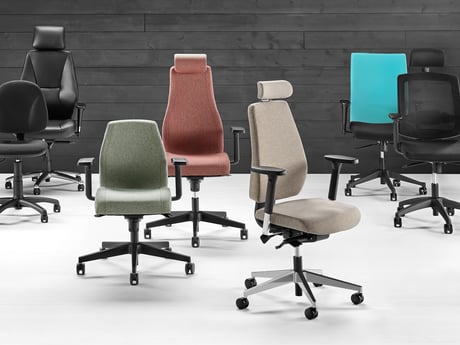How to set up an ergonomic workshop

Musculoskeletal disorders (MSDs) are a common problem in industrial work sectors due to repetitive tasks and awkward postures. MSDs are one of the leading causes of long-term sick leave, accounting for 6.9 million lost working days in the UK in the 2018-2019 period according to the Health and Safety Executive. The right work environment can reduce the chance of repetitive strain injuries and encourage healthier postures by providing furniture and equipment adapted to the work tasks, leading to more productive workdays and fewer sick days.
Find the right workbench for your work tasks

1. Sit-stand workbench
An electrically height-adjustable workbench lets you vary the working height as needed so that you can find the correct working position easily. This is particularly handy when several people use the same workstation as each person can adapt it to his/her own height. It also allows you to switch between sitting and standing depending on the task.
2. Workbench with integrated rollers
Rollers integrated into the worktop make it easier to handle and rotate goods, thus preventing occupational injuries. Some benches have a pull-out unit underneath the worktop that provides an extra work surface and is especially useful when working with large goods as the low height provides a better working position when the worktop is too high.
3. Workbenches with a back panel
Fitting a back panel to your workbench means you have everything you need close at hand while you work. The right rear assembly unit will depend on your tasks. For production, assembly or repair, tool panels allow you to hang tools to prevent you having to have to rummage through boxes or bend down to look in drawers. Rails with small parts boxes keep fixings and components within easy reach, making your work both more comfortable and more efficient. For packing, you can fit a roll holder that makes it easier to roll out kraft paper, corrugated cardboard, bubble wrap or other packaging materials stored on a roll and a sliding knife unit to make it easy to cut the material.

Prevent aches and pains with an anti-fatigue mat
When standing for long periods of time at a workbench, it is essential to have an anti-fatigue mat that provides support underfoot to reduce strain on the body. This type of mat not only provides relief from cold hard concrete floors but also encourages micro-movements that means pressure is distributed more evenly throughout the lower limbs to reduce any pain or discomfort associated with standing. Over both the short and long term, this relieves stiffness in your joints, reduces pressure on the lower back and relieves tension in the neck and shoulders. Industrial environments also require mats that are non slip, easy to keep clean and resistant to oil spills, fats and chemicals. The right mat will be able to cater for all of these requirements.
Sit comfortably in a draughtsman chair
Many workshop chairs are ergonomically designed to offer excellent support and relief to the lumbar region. A good chair has an adjustable seat and backrest angle, so you can adjust your sitting position to suit your body and your work. A draughtsman chair offers a higher seat height than a task chair so that you can work comfortably at an assembly line or packing station. If you often alternate between sitting and standing, a saddle chair or a sit-stand chair will facilitate the movement from a sitting to a standing position.
Get down lower with a workshop stool
If your work frequently demands low working heights that mean you have to squat or kneel down, a work stool is a great alternative. Sitting on a low stool prevents uncomfortable positions and provides relief for your back, knees and ankles without compromising your work.
Use the right work lighting
Poor lighting is a common cause of headaches and eye strain. Invest in good work lighting is essential, especially for tasks that involve small components such as assembly work or electronics. As well as overhead lighting, it is important to have adjustable work lights at the workstation. Employees should be able to direct the light it to where it is needed and adjust the brightness so that it be changed at different points in the day and to suit their task.


